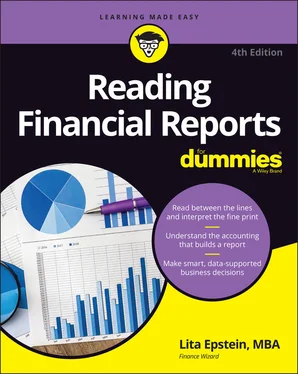Lita Epstein - Reading Financial Reports For Dummies
Здесь есть возможность читать онлайн «Lita Epstein - Reading Financial Reports For Dummies» — ознакомительный отрывок электронной книги совершенно бесплатно, а после прочтения отрывка купить полную версию. В некоторых случаях можно слушать аудио, скачать через торрент в формате fb2 и присутствует краткое содержание. Жанр: unrecognised, на английском языке. Описание произведения, (предисловие) а так же отзывы посетителей доступны на портале библиотеки ЛибКат.
- Название:Reading Financial Reports For Dummies
- Автор:
- Жанр:
- Год:неизвестен
- ISBN:нет данных
- Рейтинг книги:5 / 5. Голосов: 1
-
Избранное:Добавить в избранное
- Отзывы:
-
Ваша оценка:
- 100
- 1
- 2
- 3
- 4
- 5
Reading Financial Reports For Dummies: краткое содержание, описание и аннотация
Предлагаем к чтению аннотацию, описание, краткое содержание или предисловие (зависит от того, что написал сам автор книги «Reading Financial Reports For Dummies»). Если вы не нашли необходимую информацию о книге — напишите в комментариях, мы постараемся отыскать её.
Reading Financial Reports For Dummies,
Reading Financial Reports For Dummies
Reading Financial Reports For Dummies — читать онлайн ознакомительный отрывок
Ниже представлен текст книги, разбитый по страницам. Система сохранения места последней прочитанной страницы, позволяет с удобством читать онлайн бесплатно книгу «Reading Financial Reports For Dummies», без необходимости каждый раз заново искать на чём Вы остановились. Поставьте закладку, и сможете в любой момент перейти на страницу, на которой закончили чтение.
Интервал:
Закладка:
 Forget everything you think you know about debits and credits! You're going to have to erase these assumptions from your mind to understand double-entry accounting, which is the basis of most accounting done in the business world.
Forget everything you think you know about debits and credits! You're going to have to erase these assumptions from your mind to understand double-entry accounting, which is the basis of most accounting done in the business world.
Both cash-basis and accrual accounting use this method, in which a credit may be added to or subtracted from an account, depending on the type of account. The same is true with debits; sometimes they add to an account, and sometimes they subtract from an account.
Double-entry accounting
When you buy something, you do two things: You get something new (say, a chair) and you have to give up something to get it (most likely, cash or your credit line). Companies that use double-entry accounting show both sides of every transaction in their books, and those sides must be equal.
 Probably at least 95 percent of businesses in the U.S. use double-entry accounting, whether they use the cash-basis or accrual accounting method. It's the only way a business can be certain that it has considered both sides of every transaction.
Probably at least 95 percent of businesses in the U.S. use double-entry accounting, whether they use the cash-basis or accrual accounting method. It's the only way a business can be certain that it has considered both sides of every transaction.
For example, if a company buys office supplies with cash, the value of the office supplies account increases, while the value of the cash account decreases. If the company purchases $100 in office supplies, here's how it records the transaction on its books:
| Account | Debit | Credit |
|---|---|---|
| Office supplies | $100 | |
| Cash | $100 |
In this case, the debit increases the value of the Office supplies account and decreases the value of the Cash account. Both accounts are asset accounts, which means both accounts represent things the company owns that are shown on the balance sheet. (The balance sheet is the financial statement that gives you a snapshot of the assets, liabilities, and shareholders’ equity as of a particular date. I cover balance sheets in greater detail in Chapter 6.)
The assets are balanced or offset by the liabilities (claims made against the company's assets by creditors, such as loans) and the equity (claims made against the company's assets, such as shares of stock held by shareholders). Double-entry accounting seeks to balance these assets and claims. In fact, the balance sheet of a company is developed using this formula:
Assets = Liabilities + Equities
Profit and loss statements
In addition to establishing accounts to develop the balance sheet and make entries in the double-entry accounting system, companies must set up accounts that they use to develop the income statement (also known as the profit and loss statement, or P&L ), which shows a company's revenue and expenses over a set period of time. (See Chapter 7for more on revenue and expenses.) The double-entry accounting method impacts not only the way assets and liabilities (balance sheet accounts) are entered, but also the way revenue and expenses (income statement accounts) are entered.
The effect of debits and credits on sales
If you're a sales manager tracking how your department is doing for the year, you want to be able to decipher debits and credits. If you think you've found an error, your ability to read reports and understand the impact of debits and credits is critical. For example, anytime you think the income statement doesn't accurately reflect your department's success, you have to dig into the debits and credits to be sure your sales are being booked correctly. You also need to be aware of the other accounts — especially revenue and expense accounts — that are used to book transactions that impact your department.
A common entry that impacts both the balance sheet and the income statement is one that keeps track of the amount of cash customers pay to buy the company's product. If the customers pay $100, here's how the entry looks:
| Account | Debit | Credit |
|---|---|---|
| Cash | $100 | |
| Sales revenue | $100 |
In this case, both the Cash account and the Sales revenue account increase. One increases using a debit, and the other increases using a credit. Yikes — I know, accounting can be so confusing! Whether an account increases or decreases from a debit or a credit depends on the type of account it is. See Table 4-1to find out when debits and credits increase or decrease an account.
 Make a copy of Table 4-1and tack it up where you review your department's accounts until you become familiar with the differences.
Make a copy of Table 4-1and tack it up where you review your department's accounts until you become familiar with the differences.
TABLE 4-1Effect of Debits and Credits
| Account | Debits | Credits |
|---|---|---|
| Assets | Increases | Decreases |
| Liabilities | Decreases | Increases |
| Income | Decreases | Increases |
| Expenses | Increases | Decreases |
Depreciation and amortization
 Depreciation and amortization are accounting methods you use to track the use of an asset and record its value as it ages. Tangible assets (assets you can touch or hold in your hand, like cars or inventory) are depreciated (reduced in value by a certain percentage each year to show that the company is using up the tangible asset). Intangible assets (like intellectual property or patents) are amortized (reduced in value by a certain percentage each year to show that the company is using up the intangible asset) .
Depreciation and amortization are accounting methods you use to track the use of an asset and record its value as it ages. Tangible assets (assets you can touch or hold in your hand, like cars or inventory) are depreciated (reduced in value by a certain percentage each year to show that the company is using up the tangible asset). Intangible assets (like intellectual property or patents) are amortized (reduced in value by a certain percentage each year to show that the company is using up the intangible asset) .
For example, each vehicle a company owns loses value throughout the normal course of business every year. Cars and trucks are usually estimated to have five years of useful life, which means the number of years the vehicle will be of use to the company.
Suppose a company pays $30,000 for a car. To calculate its depreciation on a five-year schedule, divide $30,000 by 5 to get $6,000 in depreciation. Each of the five years this car is in service, the company records a depreciation expense of $6,000.
When the company makes the initial purchase of the vehicle using a loan, it records the purchase this way:
| Account | Debit | Credit |
|---|---|---|
| 2021 ABC company car | $30,000 | |
| Loans payable — Vehicles | $30,000 |
In this transaction, both the debit and the credit increase the accounts affected. The debit recording the car purchase increases the total of the assets in the vehicle account, and the credit recording the new loan also increases the total of the loans payable for cars.
The company records its depreciation expenses for the car at the end of each year this way:
| Account | Debit | Credit |
|---|---|---|
| Depreciation expense | $6,000 | |
| Accumulated depreciation — Vehicles | $6,000 |
In this case, the debit increases the expense for depreciation. The credit increases the amount accumulated for depreciation. The line item Accumulated depreciation — Vehicles is listed directly below the asset Vehicles on the balance sheet and is shown as a negative number to be subtracted from the value of the Vehicles assets. This way of presenting the information on the balance sheet helps the financial report reader quickly see how old an asset is and how much value and useful life it has. Some financial reports only show the net value of an asset with deprecation already subtracted. In those cases, the financial report reader may need to find the detail in the Notes to the Financial Statement.
Читать дальшеИнтервал:
Закладка:
Похожие книги на «Reading Financial Reports For Dummies»
Представляем Вашему вниманию похожие книги на «Reading Financial Reports For Dummies» списком для выбора. Мы отобрали схожую по названию и смыслу литературу в надежде предоставить читателям больше вариантов отыскать новые, интересные, ещё непрочитанные произведения.
Обсуждение, отзывы о книге «Reading Financial Reports For Dummies» и просто собственные мнения читателей. Оставьте ваши комментарии, напишите, что Вы думаете о произведении, его смысле или главных героях. Укажите что конкретно понравилось, а что нет, и почему Вы так считаете.












